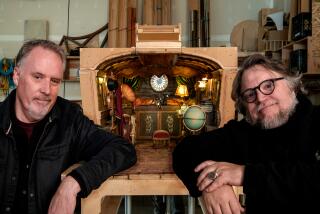A DUTCH FILM MAKER’S MANY STROKES OF GENIUS
- Share via
“I didn’t know anything about animation when I got into it,” says Dutch film maker Paul Driessen.
“When commercial television started in Holland in the early ‘60s, I read an article in the paper about the studios they were setting up in a beautiful area of the country. I went up there trying to sell some of my print cartoons. They liked my style, and within about a year I did my first few commercials. Everything in them was the way I wanted it: The ideas were mine, the style was mine. I guess I was spoiled by them--I liked doing my own work.”
Although his films are almost unknown in this country, Driessen is one of the world’s most popular and prolific independent animators. He made his first Southern Californian appearance last weekend at the Festival of Animation at the La Jolla Museum of Contemporary Art. A slender, relaxed man with distinctive, angular features, Driessen discussed his work during an impromptu interview at LAX, en route to La Jolla from his home in The Hague.
“I went to art school in the evenings for five years,” he continued. “It seemed to be important to have some formal background and a paper. But I never used anything I learned there. They felt you couldn’t do cartoons until you could draw well. They made me take life drawing; I had to go out in the forest and draw trees. I just hated it!”
His work in commercials brought him to the attention of the late George Dunning, who invited him to work at his London studio. When the studio in Holland closed in 1967, Driessen accepted the offer and arrived the day before work began on “Yellow Submarine.” He spent the next year drawing story boards and animating Blue Meanies.
“I thought the experience would enable me to find work, either in a studio or as a free-lancer,” he sighs, “But there was just nothing. In desperation, I asked the Dutch government for a subsidy. So I did my first film, ‘The Story of Little Yogurt.’ It took me quite a while and was really very difficult, but I finished in the end.”
“Little Yogurt” (1968) was the first of 16 personal shorts Driessen has created in the last 18 years. His work has garnered prizes at every major animation festival in the world, including Ottawa, Zagreb and Annecy. In fact, most animators regard it as a poor festival that doesn’t include at least one Driessen film.
Although his draftsmanship remains weak, Driessen is a skillful animator who commands a unique, immediately recognizable style. His characters look as if they’d been crumpled up and thrown away, but somehow managed to escape from the wastebasket. Lumpy and misshapen, they hobble about the screen, encountering weird but hilarious situations.
In “Home on the Rails” (1981), a little old lady calmly gets up from her knitting to open the door--so an express train can roar through her cottage. When Noah’s Ark accidentally tips over in “On Land, at Sea and in the Air” (1980), two sharks swim by--and leave two bones behind them. A man eats a soft-boiled egg (despite its protests) in “The Killing of an Egg” (1977) only to discover a monstrous spoon breaking open the roof of his house.
“He’s definitely a pure animator,” comments Bob Kurtz of Kurtz and Friends. “His work is both simple and complex: It can be read on many levels, but it’s composed of simple, funny drawings. You start laughing at the first frame.” Veteran animator Bill Littlejohn, whose work includes the “Peanuts” specials, describes Driessen as “my favorite madman.”
Driessen plans to spend the next five months in Vancouver, working on a film for the coming World’s Fair. “There’s a completely automatic commuter train for Expo,” he explains. “It stops at every platform and the doors stay open for 90 seconds, so they need entertainment they can watch during those pauses. It’s a weird little short: I like it--it was fun to do.”
More to Read
The biggest entertainment stories
Get our big stories about Hollywood, film, television, music, arts, culture and more right in your inbox as soon as they publish.
You may occasionally receive promotional content from the Los Angeles Times.










